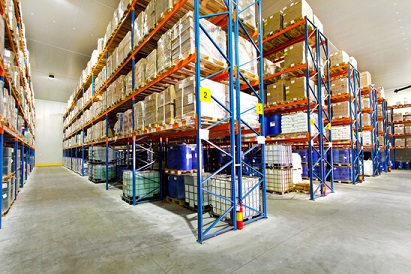Title Page
-
Location
-
Conducted on (Date and Time)
-
Inspected by
General Inspection
General Information
-
Nature of business
-
Materials and Products Stored
-
Current Stores Manager
General Warehouse Areas
-
Are aisles clear and open for stock movement? <br>• No product shall be stored in aisles where it blocks equipment maneuvering.
-
Please upload a photograph
-
Please insert photograph
-
REFERENCE: Clean aisles. No materials are stored in walkways.
[This is an example of how you can use iAuditor to include best practice reference images in your templates to assist with inspections] -
Are floor and rack storage limits properly posted? <br>• All racks should be labeled with load ratings.
-
Please insert photograph
-
Are rack uprights and beams in good condition? <br>• Bent racks and beams must be repaired or replaced. <br>• All racks should be bolted to the floor.<br>• All FLT racks should be bolted to the wall
-
Please insert photograph of any items that require repair or replacement
-
Are fire extinguishers up to date for inspections and in good condition?<br>• Verify employees have received appropriate training and education.
-
Photograph of indate Fire Extinguisher Service Sheet
-
Are all emergency exits clear of blockage and are the exit signs in good condition? <br>• Inspect both inside and outside for blockage of the exits. <br>• All exit signs should be lit & all emergency lights tested.
-
Insert Photograph
-
Insert Photograph
-
Are all pallets in good condition? <br>• Empty pallets must be stored properly. <br>• No broken or protruding wood or nails. <br>• No pallets on edge.
-
Please insert photographs of any broken or damaged pallets
-
Are overhead lighting, skylights, and roofs in good condition? <br>• Check for leaks, broken panels/light bulbs, and missing bulb shields.
-
Please insert photographs of any issues?
-
Are loose/unboxed materials stacked properly?<br>• Properly stored by blocking, interlocking or limiting the height of the pile.<br>• Insure product stack heights are inforced to prevent container crushing and falling materials.
-
Are all bags, containers, bundles, etc. stored in tiers that are stacked, blocked, interlocked and limited in height? <br>• Stable and secure to prevent sliding or collapse.
-
Are all employees use proper personal protective equipment when handling chemicals?
-
Are guardrails and/or covers provided to protect personnel from the hazards of open sides of stairs, platforms, floor openings, floor holes, mezzanines, equipment pits, and other possible fall hazards?
-
All hazardous materials' containers are properly labeled?<br>• Indicated chemical’s identity, the manufacturer’s name and address, and appropriate hazard warnings.
-
Are all chemicals stored according to the manufacturer’s recommendations and local or national fire codes. (i.e. flammable cabinets, cans, etc.)?
-
Are all employees use the proper lifting technique for the materials being handled?
-
Products and containers that are most frequently moved by hand are stored at rack heights that minimize bending / stooping or excess reach to pick up or place?
Dock Areas (Exterior and Interior)
Dock Areas (Exterior)
-
Are approach roads and staging areas (yard) clear for maneuvering, well drained, free of potholes and are all signs in place and legible?
-
Is the approach to the dock well drained and free from potholes or other obstructions? <br>• Pay particular attention to snow, ice, storm water and debris build up.
-
Are all exterior lights working properly? <br>• This item will need to be inspected during the evening when lights are functioning.
Dock Areas (Interior)
-
Are all interior overhead lights and trailer lights in the dock area operating properly? <br>• Test all lights that might be off at time of inspection to be sure they work properly
-
Do dock doors work properly and close completely? <br>• Ensure that all doors in use open and close smoothly. <br>• Inspect automatic stops and auto-reversing functions on powered doors
-
Are dock doors closed when not in use? <br>• Closed doors should seal well with the floor and dock leveling plate.
-
Is there sufficient room to maneuver materials? <br>• Dock area floors should be clean and free of trash, debris, or stored items that block the safe passage of loaded equipment
-
Are there sufficient waste cans for the area and are those cans properly labeled and emptied on a regular basis? <br>• In general, floors, ceilings, and exhaust fans are clean and free of cobwebs and dust buildup.
Equipment Check
Equipment Checks
-
Are all ladders and hand tools are in good condition? <br>• Remove any unsafe equipment from service while awaiting repair.<br>• Ensure Scaff Tags are in place
-
Are forklifts being operated safely and inspected at the start of every shift? <br>• Observe powered industrial truck operations and review training certifications to confirm operators have been adequately trained and evaluated.
-
Do forklifts have functioning warning devices such as back-up alarms, strobes, or horns? <br>• Test equipment as needed, report repairs,and tag out equipment that is unsafe until repairs are made.
-
Are all powered industrial trucks (i.e. forklifts) meet the design and construction requirements established in regulatory standards?
-
Are the original capacity, operation and maintenance instruction plates, tags or decals on powered industrial trucks in place and legible?<br>• All authorized equipment and accessory modifications are also identified on those labels/tags/decals.
-
Are tools and other spark producing metallic objects kept away from the top of uncovered batteries?
Sanitation (For food storage facilities)
Sanitation Inspection
-
Are rodent and other pest control devices in place and in proper working condition? <br>• Look for missing or damaged traps and check fly zappers as well.
-
Are aisles, wall perimeters, exterior areas near the building, trash cans and dumpsters free of loose trash and debris?
-
Are stored products in good condition and free of spillage / breakage?
-
Are products which are broken, damaged or otherwise removed from distribution properly labeled, segregated (if required), disposed of or recouped?
-
Are the storage areas free of pests? <br>• Look for signs of pests such as dead insects, container damage caused by feeding, droppings, feathers, etc.
Training & General Safety
Training and General Safety
-
Are all employees properly trained and is training and certification up to date? <br>• Inspect records to verify training is documented and up to date.
-
Are emergency evacuation routes and guidelines posted?
-
Are the appropriate posters posted in a conspicuous place?
-
Are your employees actively and meaningfully involved in workplace safety programs? (i.e. participate in accident investigations, self inspection, committees, etc.)
-
Are accidents, near misses and injuries being investigated and are unsafe conditions being corrected, reported/documented in a timely manner?
-
Are MSDS available to employees and are they up to date and complete?
-
Are location security process and equipment in place and operating well? <br>• Inspect identification badges, uniforms, and intrusion alarms. <br>• Verify monitoring services and equipment tests.
-
Are proper and safe work practices factored in when determining the appropriate time requirements to perform tasks?
-
Are all employees properly trained and outfitted for weather/temperature extremes? (i.e. heat stress, cold weather, refrigerated storage areas, etc.)
-
Are newly-hired employees receive documented general material handling and task-specific ergonomics training? <br>• Verify through observations that employees practice safe lifting techniques on the job.
-
Are all employees trained in the requirements of the hazard communication standard?<br>• Including a review of each MSDS and the specifics of existing and potential hazards of chemicals in the work place, precautions and safe work practices.
-
Is employee training documented?
-
Is a documented pre-work program for review of all outside contractor activities in place to ensure the work they will perform and the materials they will use are compatible with the activities and materials in use in the area of their work?
-
Is refresher training and evaluation conducted and documented whenever a powered industrial truck operator is assigned to drive a different piece of equipment, attachment, or the nature of the employee's duties change in any way that might impact safety?
Sign-off
-
Additional Comments:
-
Signed:
















